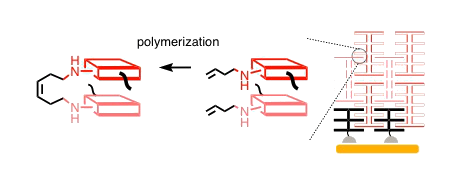- Sakurai, S.; Areephong, J.; Bertone, L.; Lin, N.-T.; Sakai, N.; Matile, S. “Toward Polymerized Artificial Photosystems with Supramolecular n/p-Heterojunctions and Antiparallel Redox Gradients” Energy Environ. Sci. 2011, 4, 2409-2416

The evaluation of the importance of both ordered and oriented supramolecular architectures for artificial photosynthesis is a topic of current scientific concern. The objective of this study was to synthesize polymerizable zipper architectures and determine the impact of zipper polymerization on the performance of artificial photosystems. We report the synthesis of negatively and positively charged red naphthalenediimides that are equipped with short and long alkenyl tails and attached along oligophenylethynyl scaffolds. The presence of the short butenyl tails turns out to be tolerated by zipper assembly, whereas those of the longer undecenyl tails are not acceptable. Polymerization of the short-tailed zippers with olefin metathesis, using different catalysts in different solvents, is consistently found to reduce the photocurrent generation. These results suggest that polymerization indeed takes places but disturbs rather than stabilizes supramolecular zipper architectures, i.e., that supramolecular systems perform better than macromolecular architectures, at least in the context of this study. We conclude that constructive covalent capture of artificial photosystems should occur during and not after the self-organization of the artificial photosystems. This important conclusion calls for the invention of self-organizing polymer brushes for the synthesis of advanced organic photosystems.
DOI: 10.1039/C0EE00648C
open archive unige:16527 • pdf ![]()
